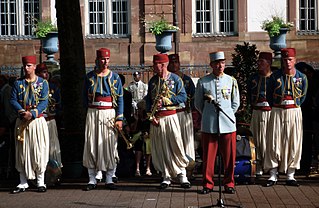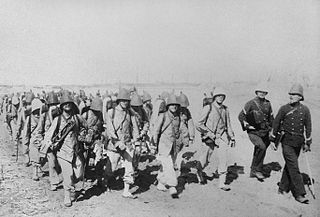 W
WThe French colonial empire constituted the overseas colonies, protectorates and mandate territories that came under French rule from the 16th century onward. A distinction is generally made between the "First French Colonial Empire," that existed until 1814, by which time most of it had been lost or sold, and the "Second French Colonial Empire", which began with the conquest of Algiers in 1830. At its apex, the Second French colonial empire was one of the largest empires in history. Including metropolitan France, the total amount of land under French sovereignty reached 11,500,000 km2 (4,400,000 sq mi) in 1920, with a population of 110 million people in 1936.
 W
WThe French colonization of the Americas began in the 17th century, and continued on into the following centuries as France established a colonial empire in the Western Hemisphere. France founded colonies in much of eastern North America, on a number of Caribbean islands, and in South America. Most colonies were developed to export products such as fish, rice, sugar, and furs.
 W
WThe Algerian popular resistance against French invasion is the historic process that the Algerian people undertook to counter the invasion of French colonial troops on Algerian soil.
 W
WThe Archives nationales d'outre-mer in Aix-en-Provence is a branch of the Archives Nationales of France that documents the French colonial empire. According to one scholar, "half the history of France overseas was represented in the mass of papers" first assembled in Aix in 1966. The materials originated in various offices and repositories scattered throughout the colonies. The Dépôt des Archives d'Outre-Mer opened in 1966, and its successor, the Centre des Archives d'Outre-Mer, in 1987. It was later renamed the "Archives nationales d'outre-mer." Its facilities occupy a site near the Université de Provence Aix-Marseille I.
 W
WBanque d'Afrique Occidentale : was a bank French colonial authorities established in 1901 in Dakar, Sénégal, as the central bank of the colonies of French West Africa.
 W
WThe term French West Indies or French Antilles refers to the eight territories currently under French sovereignty in the Antilles islands of the Caribbean:The two overseas departments of: Guadeloupe, including the islands of Basse-Terre, Grande-Terre, Les Saintes, Marie-Galante, and La Désirade. Martinique The two overseas collectivities of: Saint Martin Saint Barthélemy
 W
WXavier Coppolani (1866-1905), was a French military and colonial leader, who was instrumental in the colonial occupation and creation of modern-day Mauritania.
 W
WThe École nationale de la France d'outre-mer was a French grande école, providing training for future colonial administrators. It was situated in Paris, avenue de l'Observatoire, 2.
 W
WThe enclaves of Forcados and Badjibo were two territories close to the river Niger, in modern Nigeria, leased to France by the United Kingdom under the Anglo-French Convention of 1898. They were obtained by France after several expeditions along the Niger, by Hourst (1894), Granderye (1898–99), Toutée, and Lenfant. France wanted to determine whether its colonies in French Sudan could more easily be supplied upstream along the Niger rather than via the traditional Dakar route.
 W
Wes-Saada was an arabophone weekly newspaper published in Morocco that served as the mouthpiece of the French government. The newspaper was financed by France, originally printed at the French Legation in Tangier, and used as a tool with which to spread French ideas among Moroccans. It reached all cities of Greater Morocco. Its content has been described as distinctively colonial and disruptive of public opinion in Morocco.
 W
WÉvolué is a French label used during the colonial era to refer to a native African or Asian who had "evolved" by becoming Europeanised through education or assimilation and had accepted European values and patterns of behavior. It is most commonly used to refer to individuals within the Belgian and French colonial empires. Évolués spoke French, followed European laws, usually held white-collar jobs, and lived primarily in urban areas of the colony.
 W
WThe French colonial empire was the set of territories outside Europe that were under French rule from the 16th century to the late 1980s. From the 16th to the 17th centuries, the First French colonial empire stretched from a total area at its peak in 1680 to over 10,000,000 square kilometres (3,900,000 sq mi), the second largest empire in the world at the time behind only the Spanish Empire. In terms of land area, the Second French colonial empire extended to over 13,500,000 square kilometres (5,200,000 sq mi) at its peak in 1936, the second largest in the world at the time, which accounted for 10% of the world's land area. The total land area of the first and second French colonial empire combined reached 24,000,000 square kilometres (9,300,000 sq mi).
 W
WThe Fashoda Incident was the climax of imperial territorial disputes between Britain and France in East Africa, occurring in 1898. A French expedition to Fashoda on the White Nile river sought to gain control of the Upper Nile river basin and thereby exclude Britain from the Sudan. The French party and a British-Egyptian force met on friendly terms, but back in Europe, it became a war scare. The British held firm as both empires stood on the verge of war with heated rhetoric on both sides. Under heavy pressure, the French withdrew, ensuring Anglo-Egyptian control over the area. The status quo was recognised by an agreement between the two states acknowledging British control over Egypt, while France became the dominant power in Morocco. France had failed in its main goals.
 W
WIn international relations, Françafrique is France’s sphere of influence over former French and Belgian colonies in sub-Saharan Africa. The term was derived from the expression France-Afrique, which was used by the first president of Ivory Coast, Félix Houphouët-Boigny, in 1955 to describe his country's close ties with France. It was later renamed Françafrique by François-Xavier Verschave in 1998 to criticise the alleged corrupt and clandestine activities of various Franco-African political, economic and military networks.
 W
WSome of the colonies, protectorates and mandates of the French Colonial Empire used distinctive colonial flags. These most commonly had a French Tricolour in the canton.
 W
WFrench Indochina, officially known as the Indochinese Union from 1887 and the Indochinese Federation after 1947, was a grouping of French colonial territories in Southeast Asia until its demise in 1954. It comprised three Vietnamese regions of Tonkin in the north, Annam in the centre, and Cochinchina in the south, Cambodia, Laos and the Chinese territory of Guangzhouwan. The capital for most of its history (1902–45) was Hanoi; Saigon was the capital from 1887 to 1902 and again from 1945 to 54.
 W
WThe French Union (1946–1958) was a political entity created by the French Fourth Republic to replace the old French colonial system, colloquially known as the "French Empire". It was the formal end of the "indigenous" status of French subjects in colonial areas.
 W
WThe Grand Palais or Grand Palais de l'Exposition was an exhibition and trade fair complex in Hanoi, Vietnam. It was built for the 1902 Hanoi Exhibition world trade fair, as the city became the capital of French Indochina. It was completely destroyed by airstrikes at the end of World War II.
 W
WThe Hanoi Exhibition was a world's fair held in Hanoi between November 16, 1902 and February 15 or 16, 1903.
 W
WThe Code de l'indigénat, called régime de l'indigénat or simply indigénat by modern French historians, were diverse and fluctuating sets of laws and regulations characterized by arbitrariness which created in practice an inferior legal status for natives of French colonies from 1881 until 1944–1947.
 W
WA League of Nations mandate was a legal status for certain territories transferred from the control of one country to another following World War I, or the legal instruments that contained the internationally agreed-upon terms for administering the territory on behalf of the League of Nations. These were of the nature of both a treaty and a constitution, which contained minority rights clauses that provided for the rights of petition and adjudication by the International Court.
 W
WThe metropole is the homeland or central territory of a colonial empire. The term was mainly used in the scope of the British, French and Portuguese empires to designate their European territories, as opposed to their colonial or overseas territories.
 W
WThe Mokrani Revolt, known locally as the Unfaq urrumi,, which broke out on 16 March 1871, was the most important local uprising against French colonial power in Algeria since the conquest in 1830 : more than 250 tribes rose up, around a third of the population of the country. It was led by the Kabyles of the Biban mountains commanded by Cheikh Mokrani and his brother Boumezrag Mokrani, as well as Cheikh El Haddad, head of the Rahmaniyya religious fraternity.
 W
WThe Mexican Empire or Second Mexican Empire was the name of Mexico under a constitutional hereditary monarchy declared by a Mexican Assembly of Notables in accordance with the interests of the French Empire, during the Second French intervention in Mexico. Napoleon III of France wanted to establish a monarchist ally in the Americas as a restraint upon the growing power of the United States. Chosen as the Mexican emperor was Austrian Archduke Ferdinand Maximilian, of the House of Habsburg-Lorraine. His wife and empress of Mexico was Belgian princess, Charlotte of the House of Saxe-Coburg and Gotha.
 W
WThe Shanghai French Concession was a foreign concession in Shanghai, China from 1849 until 1943, which progressively expanded in the late 19th and early 20th centuries. The concession came to an end in 1943 when the French State under German pressure signed it over to the pro-Japanese Reorganized National Government of China in Nanjing. For much of the 20th century, the area covered by the former French Concession remained the premier residential and retail district of Shanghai, and was also one of the centres of Catholicism in China. Despite re-development over the last few decades, the area retains a distinct character and is a popular tourist destination.
 W
WA tirailleur, in the Napoleonic era, was a type of light infantry trained to skirmish ahead of the main columns. Subsequently tirailleurs was used by the French Army as a designation for indigenous infantry recruited in the French colonial territories during the 19th and 20th centuries, or for metropolitan units serving in a light infantry role.
 W
WThe Troupes coloniales or Armée coloniale, commonly called La Coloniale, were the military forces of the French colonial empire from 1900 until 1961. From 1822 to 1900 these troops were designated Troupes de marine, and in 1961 they readopted this name. They were recruited from mainland France or from the French settler and indigenous populations of the empire. This force played a substantial role in the conquest of the empire, in World War I, World War II, the First Indochina War and the Algerian War.
 W
WThe Voulet–Chanoine Mission or Central African-Chad Mission was a French military expedition sent out from Senegal in 1898 to conquer the Chad Basin and unify all French territories in West Africa. This expedition operated jointly with two other expeditions, the Foureau-Lamy and Gentil missions, which advanced from Algeria and Middle Congo respectively. The refusal of the expedition commander and his second-in-command to follow orders from France, their murder of a commanding officer and their subsequent deaths at the hands of their own soldiers cast a dark shadow over France's emerging colonial empire in Africa at the end of the 19th century. The expedition is remembered for its descent into depravity and extreme violence, actions which today would legally be considered war crimes.